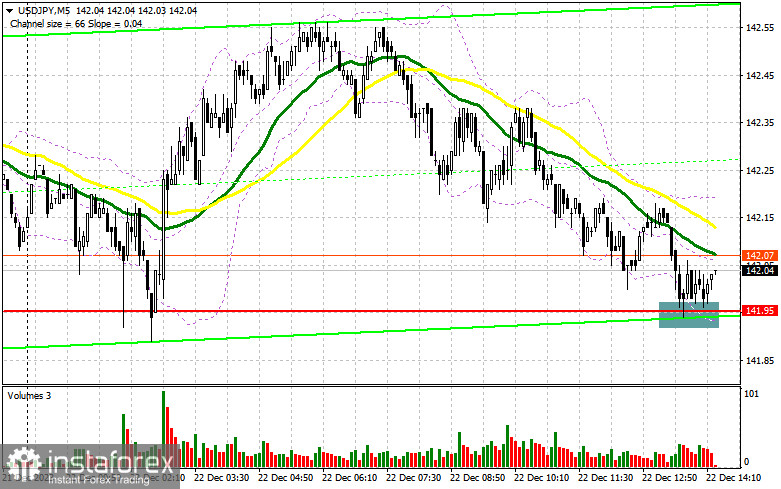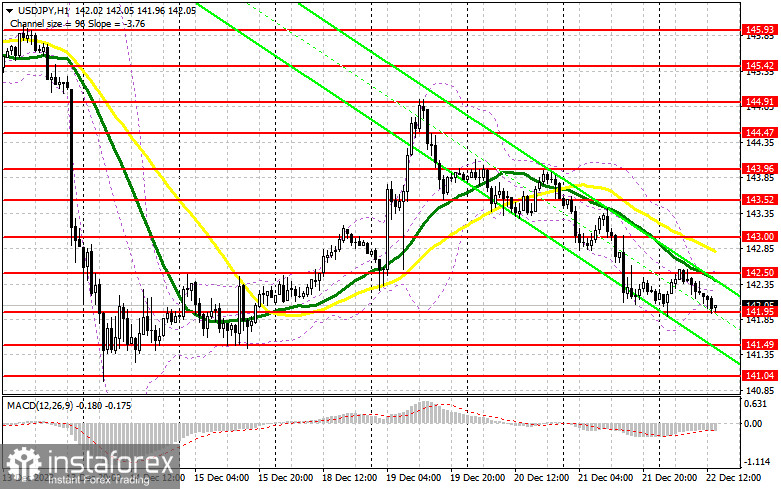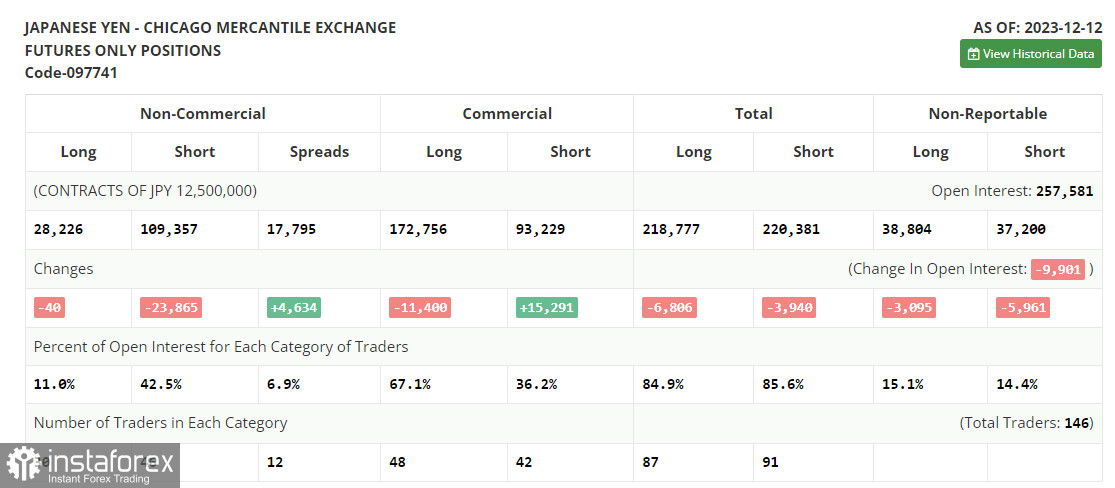In my morning forecast, I paid attention to the level of 141.95 and planned to make decisions regarding market entry based on it. Let's look at the 5-minute chart and analyze what happened there. The decline and the formation of a false breakout around 141.95 allowed for an excellent buy signal. By writing this article, the pair had moved up about 25 points, and that's where it stands now. I should have reevaluated the technical picture for the second half of the day.

To open long positions on USD/JPY, the following is required:
Ahead lies crucial statistics that can either help the dollar regain its position or weaken it further against the yen. The most interesting figures will be those related to the core Personal Consumption Expenditure (PCE) index – the Federal Reserve's preferred inflation indicator- and changes in US consumer spending and income levels. An increase in inflation will lead to an upward surge in the pair, while its decrease will continue the bearish trend. As long as trading remains above 141.95, one can anticipate a recovery in the pair even before the statistics are released, and then it depends on how things unfold. In the case of another decline in USD/JPY, I plan to act similarly to the morning strategy, only on the decline after forming a false breakout around 141.95 to recover to the daily maximum of 142.50. The moving averages are located there, limiting the pair's upward potential. Only a breakthrough and a reverse test from top to bottom of this range will be a suitable option for me to buy, capable of leading to a larger correction of the pair to the area of 143.00. The ultimate target will be the area of 143.52, where I will take profit. In the scenario of further decline in USD/JPY and the absence of activity at 141.95 from buyers in the second half of the day, pressure on the pair will persist, leading to a new sell-off. In such a case, I will attempt to enter the market around 141.49. But only a false breakout will allow me to open long positions. I plan to buy USD/JPY immediately on the rebound only from 141.04 with the aim of a correction within the day by 30-35 points.
To open short positions on USD/JPY, the following is required:
Sellers continue to press the pair, but no one is insured against an upward surge in the second half of the day after the data. In the case of strong US statistics and an upward movement of USD/JPY, I will act after forming a false breakout at 142.50. In this scenario, I will expect another decline to 141.95. A breakthrough and a reverse test from the bottom to the top of this range will deal a more serious blow to buyer positions, leading to the removal of stop orders and opening the way to 141.49. There, I expect the manifestation of large buyers. A more distant target will be the area of 141.04, where I will take profit. With USD/JPY growth and the absence of activity at 142.50, demand for the dollar will return, and we will see a larger upward correction at the end of the week. In such a case, I will postpone sales until testing the next resistance at 143.00. Without downward movement, I will sell USD/JPY immediately on the rebound from 143.52, but only with the expectation of a pair's correction down by 30-35 points within the day.


Indicator signals:
Moving averages
Trading is conducted below the 30 and 50-day moving averages, indicating a further decline in the pair.
Note: The author considers the periods and prices of moving averages on the hourly chart (H1) and differs from the general definition of classic daily moving averages on the daily chart (D1).
Bollinger Bands
In case of a decrease, the lower boundary of the indicator will act as support around 141.95.
Description of indicators:
Moving Average (MA) - determines the current trend by smoothing volatility and noise. Period 50. Marked on the chart in yellow.
Moving Average (MA) - determines the current trend by smoothing volatility and noise. Period 30. Marked on the chart in green.
Moving Average Convergence Divergence (MACD) - Fast EMA period 12, Slow EMA period 26, SMA period 9.
Bollinger Bands - a volatility indicator consisting of an SMA and two standard deviations. Period 20.
Non-commercial traders are speculators, such as individual traders, hedge funds, and large institutions, who use the futures market for speculative purposes and meet specific requirements.
Long non-commercial positions represent the total long open positions of non-commercial traders.
Short non-commercial positions represent the total short open positions of non-commercial traders.
The total non-commercial net position is the difference between non-commercial traders' short and long positions.





















